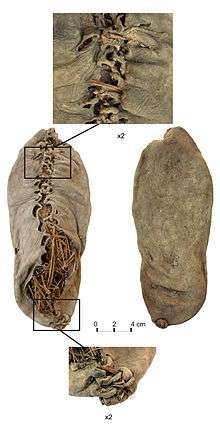Areni-1 shoe

The Areni-1 shoe is a 5,500-year-old leather shoe that was found in 2008 in excellent condition in the Areni-1 cave complex located in the Vayots Dzor province of Armenia.[1] It is a one-piece leather-hide shoe that has been dated as a few hundred years older than the one found on Ötzi the Iceman, making it the oldest piece of leather footwear in the world known to contemporary researchers. Much older footwear, 10,000-year-old sandals made of sagebrush fiber, has been discovered in the United States at Fort Rock Cave in Oregon.[2] By evidence found to date, the use of shoes arose between 40,000 and 26,000 years ago.[3][4] The discovery was made by an international team led by Boris Gasparyan, an archaeologist from the Institute of Archaeology and Ethnography of the National Academy of Sciences of Armenia (co-directors of the project are Ron Pinhasi from University College Cork in Ireland, and Gregory Areshian from UCLA).[5]
Discovery
An Armenian post-graduate student, Diana Zardaryan, discovered the leather shoe in the course of excavations by a team of archeologists from Armenia’s Institute of Archaeology and Ethnography, Ireland and the United States.[6] The shoe was found upside down at the base of a shallow, rounded, and plastered pit that was 45 cm (18 in) deep and 44–48 cm (17–19 in) wide, beneath an overturned broken Chalcolithic ceramic bowl.[7] A broken pot and goat horns also were found nearby. Excavations in the same area also found the world's oldest wine-making site.[8]
The research was funded by the National Geographic Society, the Chitjian Foundation, the Gfoeller Foundation, the Steinmetz Family Foundation, the Boochever Foundation and the Cotsen Institute of Archaeology at UCLA.[9] The team's findings were published on June 9, 2010, in the journal PLoS ONE.
Analysis
The shoe was found in near-perfect condition due to the cool and dry conditions in the cave and a thick layer of sheep dung which acted as a solid seal. Large storage containers were found in the same cave, many of which held well-preserved wheat, barley, and apricots, as well as other edible plants.[10] The shoe contained grass and the archaeologists were uncertain as to whether this was because the grass was used as insulation to keep the foot warm, or used to preserve the shape of the shoe while not being worn. Lead archaeologist Ron Pinhasi could not determine whether the shoe belonged to a man or a woman. While small, approximately a woman's U.S. and Canada size 7, European size 37, or UK size 6, he stated that "the shoe could well have fitted a man from that era".[10] The shoe laces were preserved as well.[10]
Major similarities exist between the manufacturing technique and style of one-piece leather-hide shoes discovered across Europe and the one reported from Areni-1 Cave, suggesting that shoes of this type were worn for millennia across a large and environmentally diverse geographic region.[7] According to Pinhasi, the Areni-1 shoe is similar to the Irish pampooties, a shoe style worn in the Aran Islands up to the 1950s.[11] The shoes are very similar to the traditional shoes of the Balkans, still seen today in festivals, known as Opanci (Opanke).[12]
When the material was dated by the two radiocarbon laboratories in Oxford and California, it was established that the shoe dates back to 3,500 B.C. This date is a few hundred years older than the date given for the leather shoe found on Ötzi the Iceman, 400 years older than those found at Stonehenge, and 1,000 years older than those found at the Great Pyramid of Giza.[10]
After being treated for preservation, the Areni-1 shoe will be displayed at the History Museum of Armenia.[13]
See also
References
- ↑ Dindar, Shereen (June 9, 2010). "World's Oldest Leather Shoe Found—Stunningly Preserved". National Post. Canada. Retrieved June 11, 2010.
- ↑ "World's Oldest Shoes In Oregon – 10,000-Year-Old Sandals Found In 1938 Among 70 Pairs Unearthed Within Cave". Seattle Times. December 1, 1999. Retrieved June 13, 2010.
- ↑ Johnson, Olivia (August 24, 2005). "Bones reveal first shoe-wearers". BBC News. Retrieved June 12, 2010.
- ↑ Trinkaus, E.; Shang, H. (2008), "Anatomical evidence for the antiquity of human footwear: Tianyuan and Sunghir", Journal of Archaeological Science, 35 (7): 1928–1933, doi:10.1016/j.jas.2007.12.002.
- ↑ Bruce Bower (July 3, 2010). "Ancient shoe steps out of cave and into limelight". Science News. Retrieved September 8, 2010.
- ↑ Oldest Leather Shoe A ‘Dream’ Find For Armenian Scientist, Armenia Liberty (RFE/RL), June 12, 2010.
- 1 2 Pinhasi, Ron; Gasparian, Boris; Areshian, Gregory; Zardaryan, Diana; Smith, Alexia; Bar-Oz, Guy; Higham, Thomas (June 9, 2010). "First Direct Evidence of Chalcolithic Footwear from the Near Eastern Highlands". PloS ONE. Retrieved June 9, 2010.
- ↑ "'Oldest known wine-making facility' found in Armenia.". BBC. January 11, 2011. Retrieved January 11, 2011.
- ↑ "Oldest Leather Shoe Steps Out After 5,500 Years". Huffington Post.
- 1 2 3 4 "What's Older Than the Pyramids and Smells Worse Than a Mummy?". Fox News. June 9, 2010. Retrieved June 9, 2010.
- ↑ "5,500-year leather mocassin world's oldest shoe". AFP. June 10, 2010. Retrieved June 12, 2010.
- ↑ National Geographic: World's Oldest Leather Shoe Found—Stunningly Preserved
- ↑ Gevorgyan, Siranuysh (June 14, 2010). "Do You Have that in a Size 38?: World's oldest shoe to go on display in Yerevan". ArmeniaNow.com. Retrieved June 14, 2010.